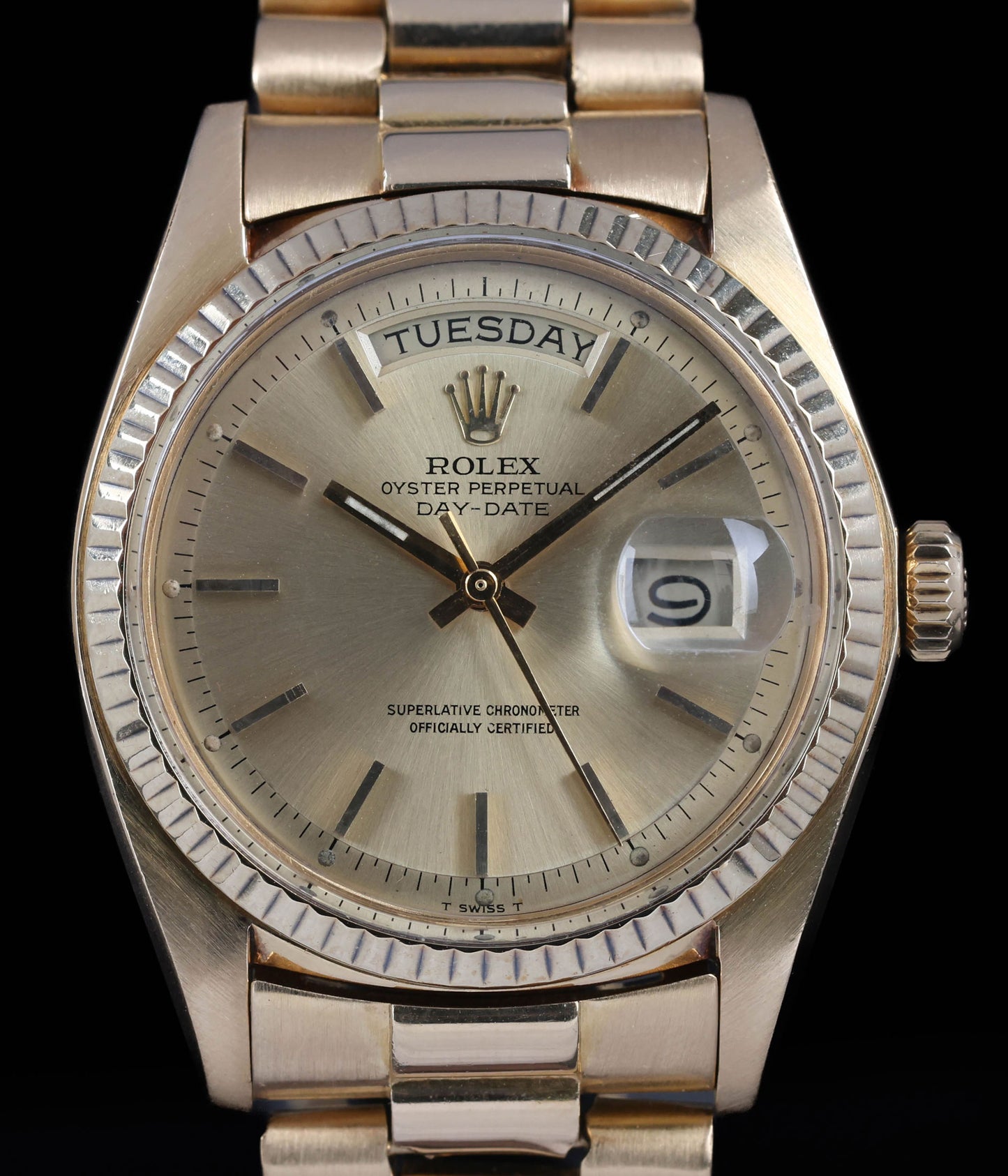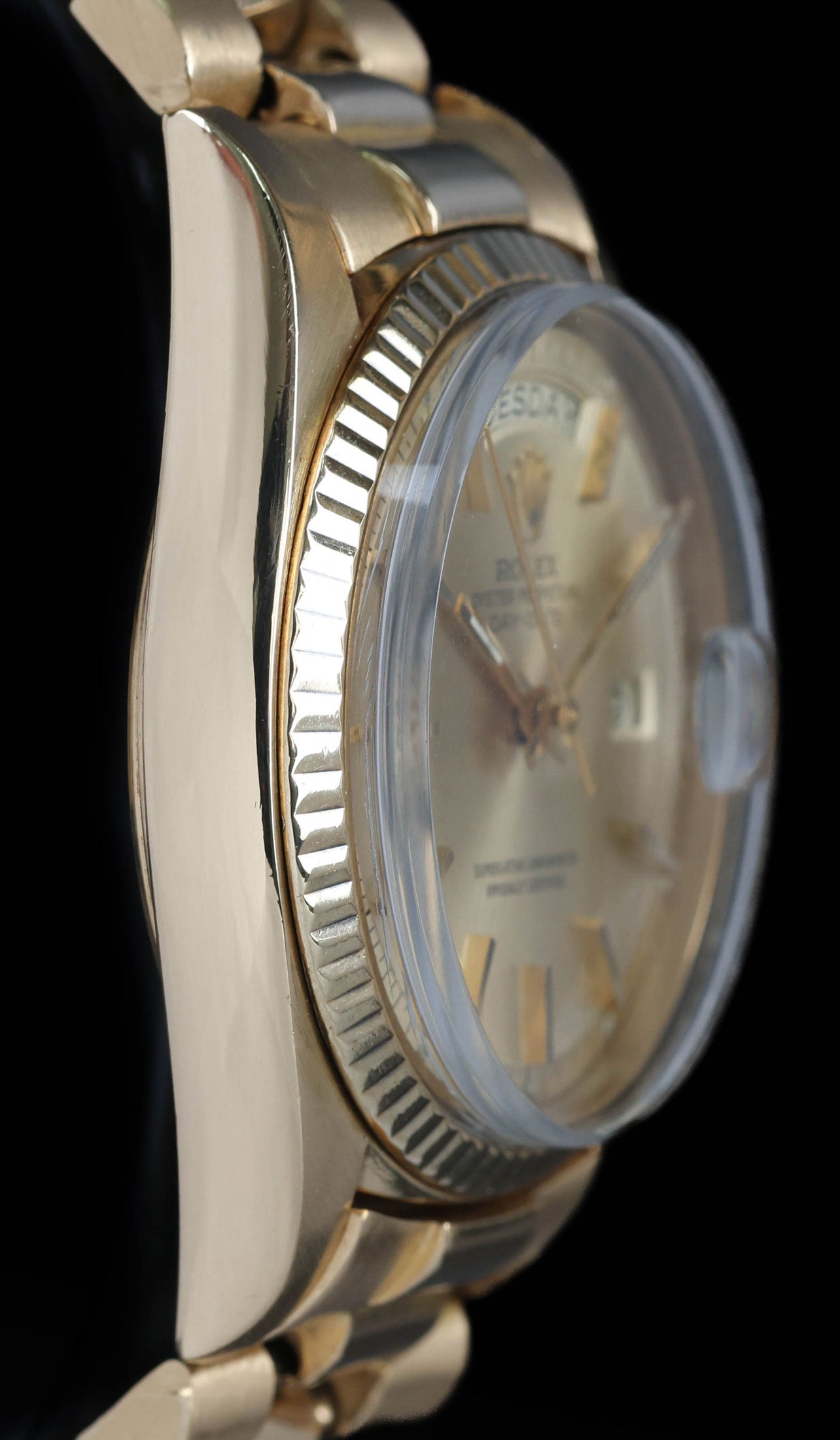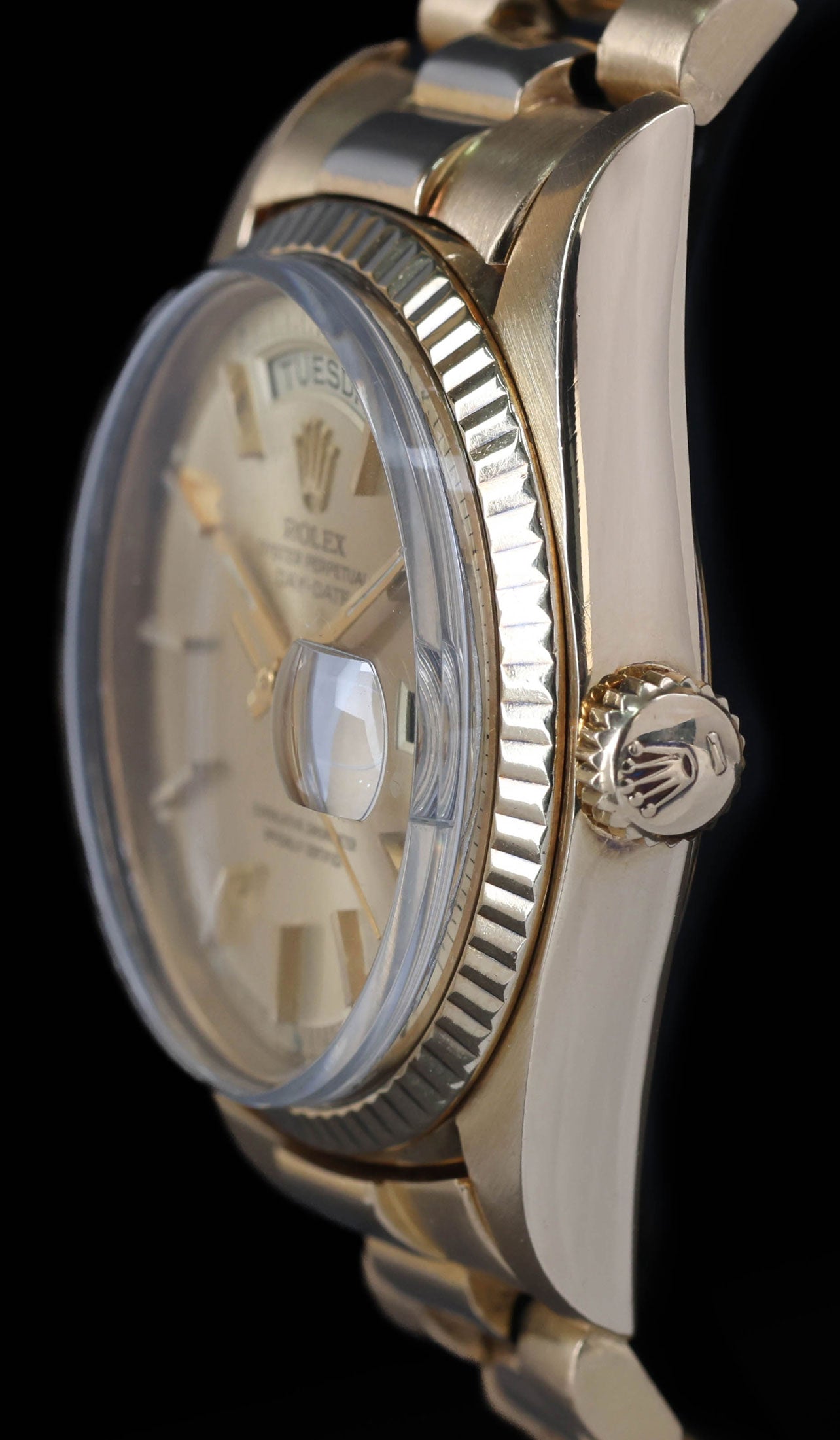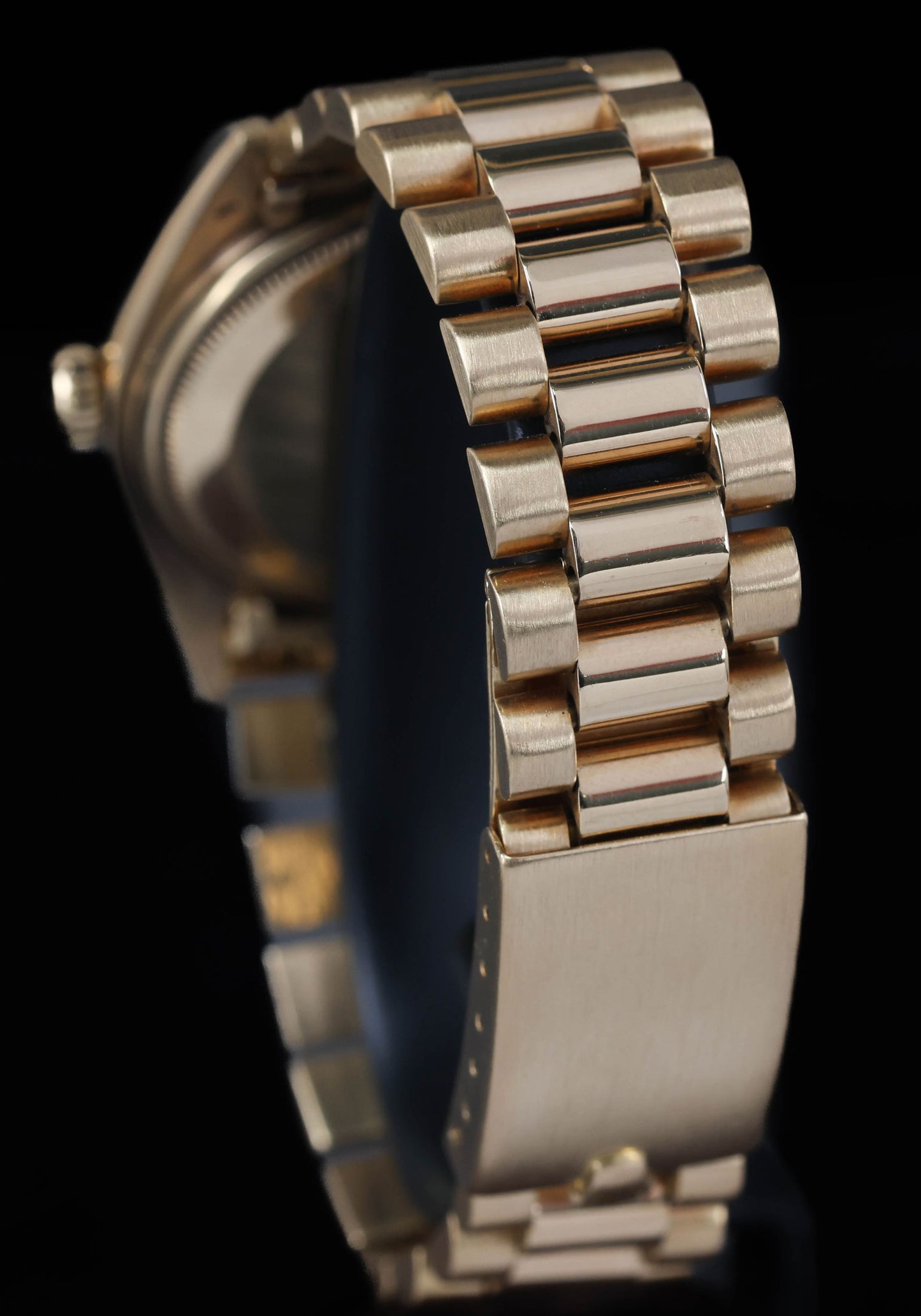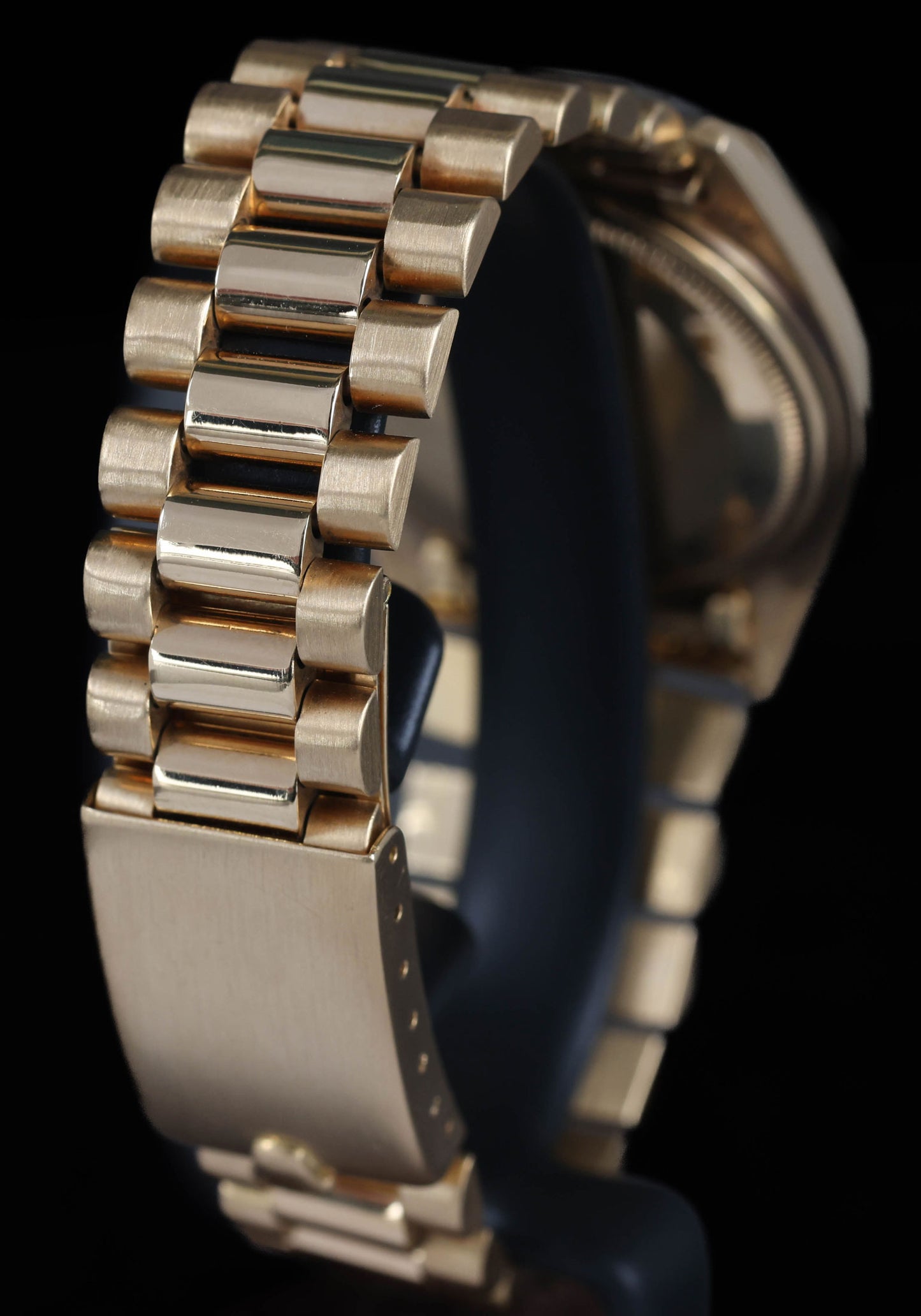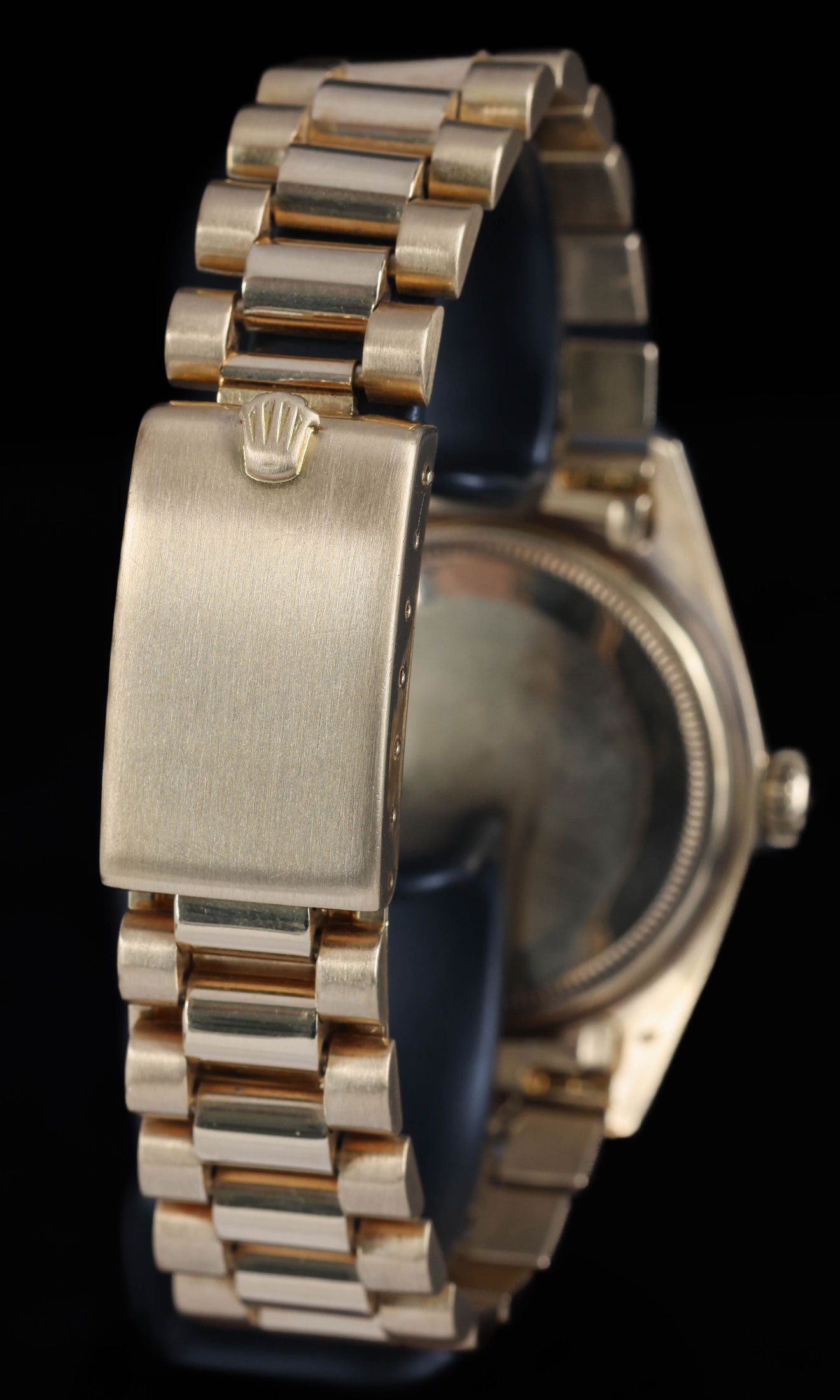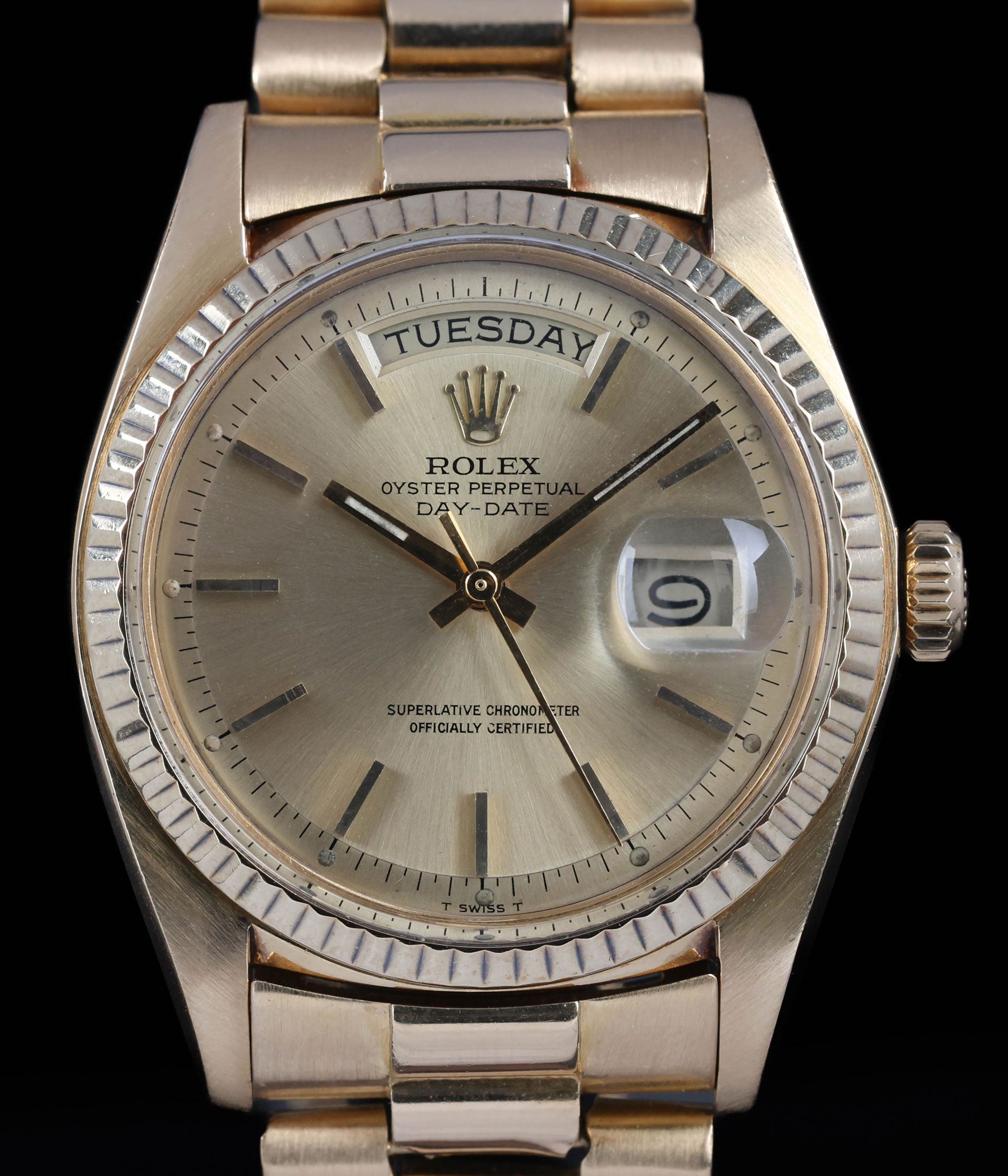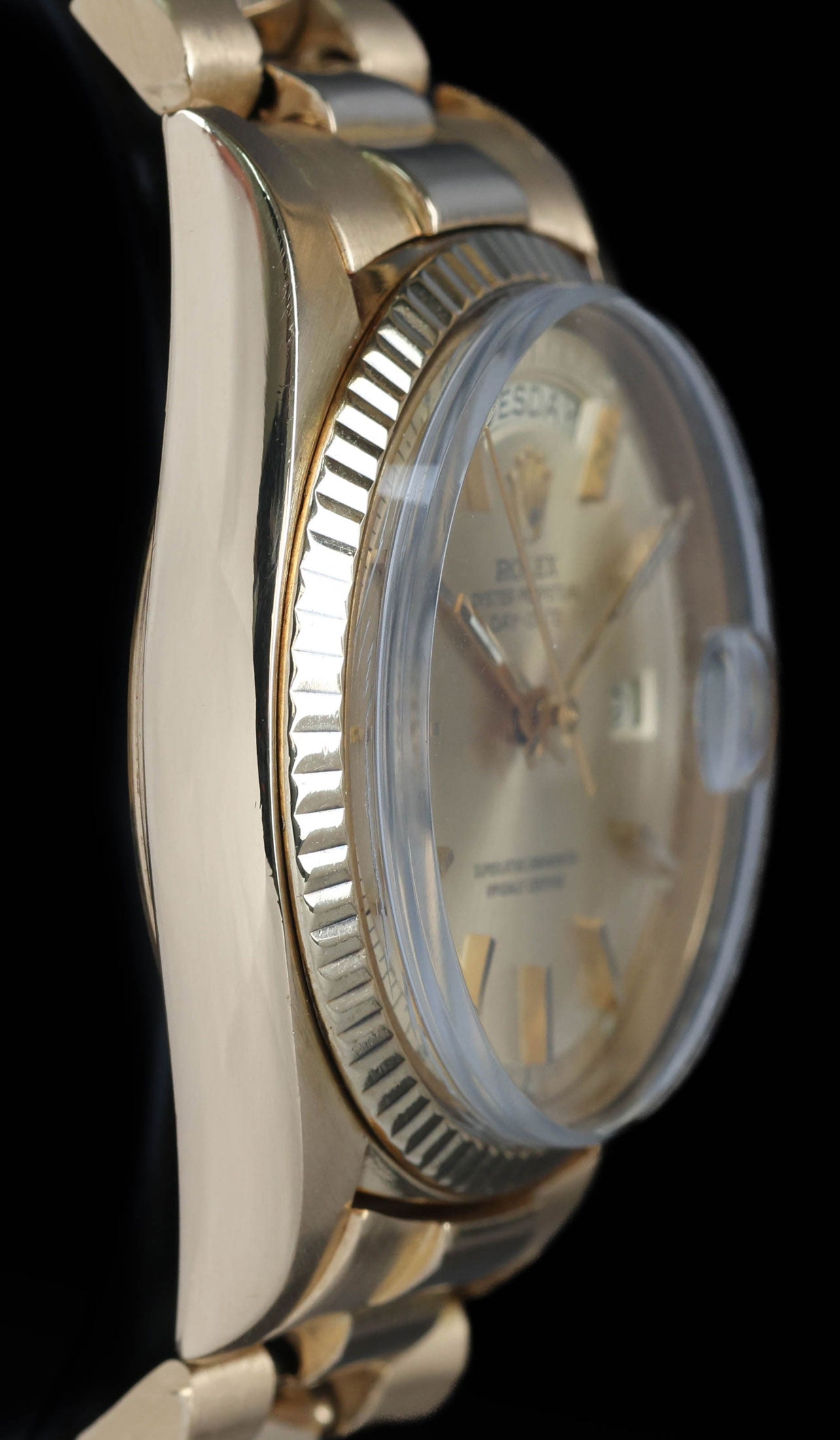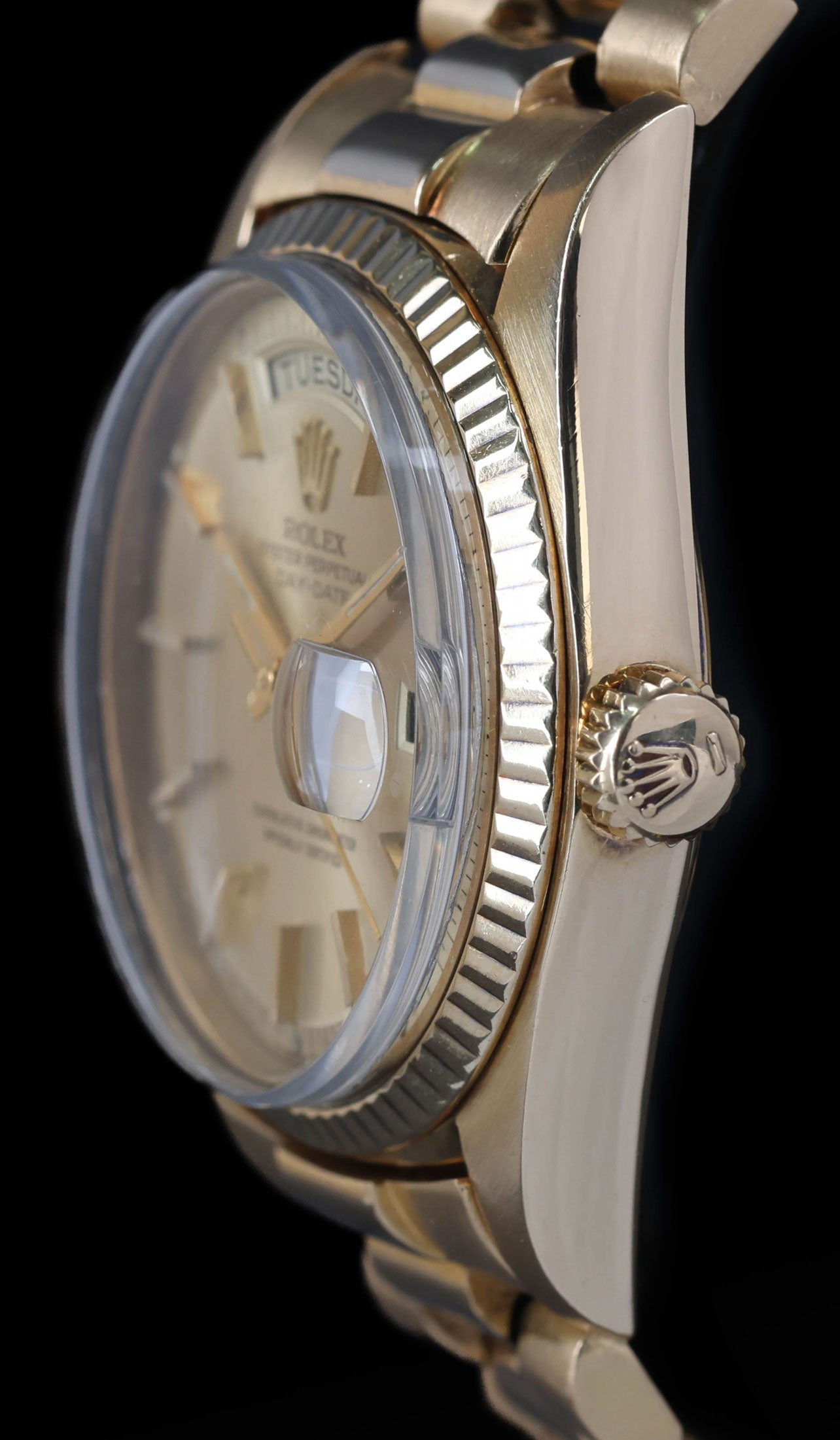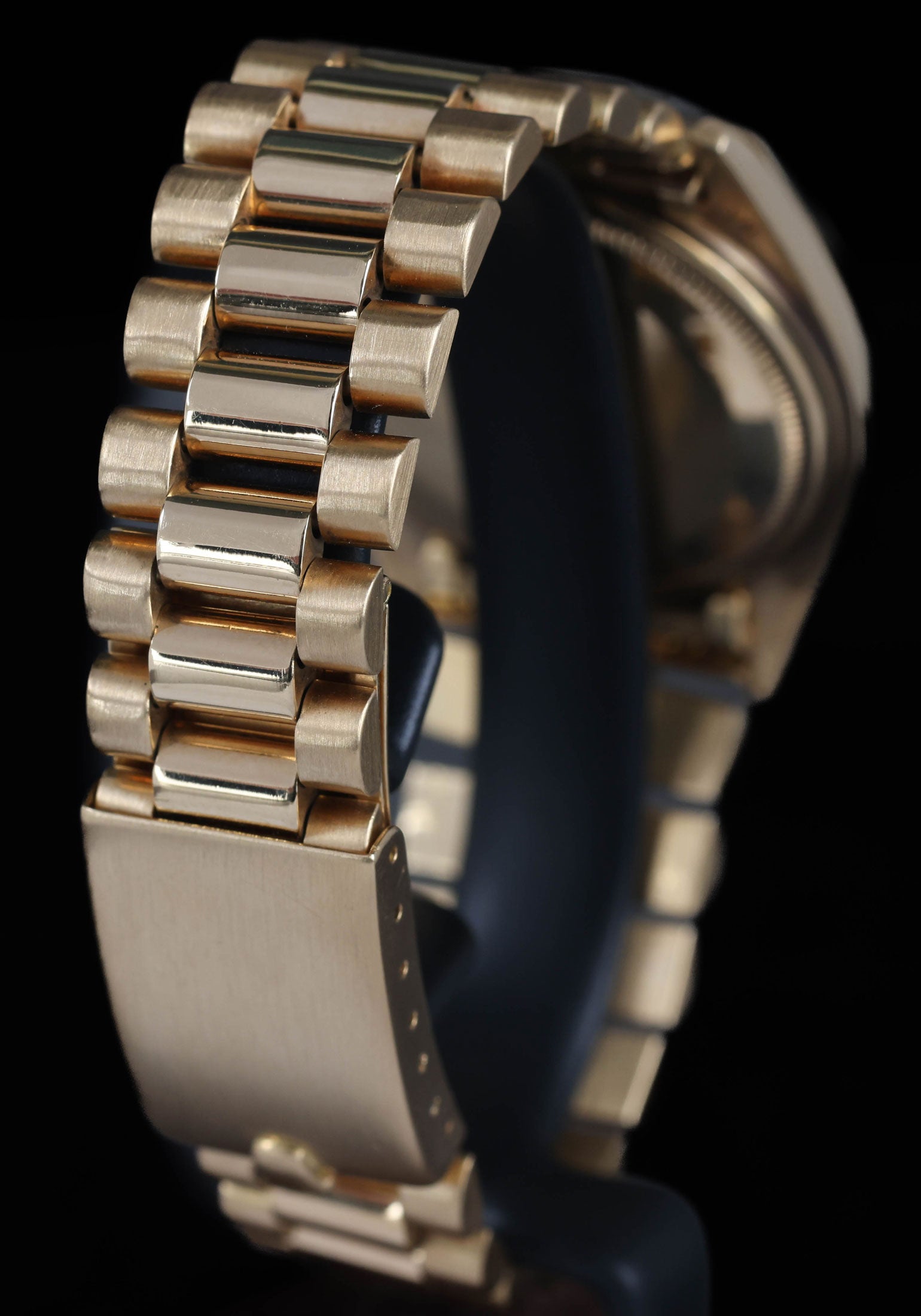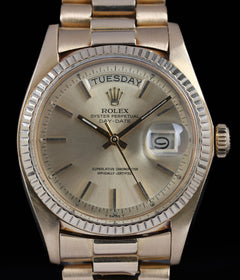Crown Vintage
Rolex Day-Date 1803 18K Yellow Gold 36MM 1974
Rolex Day-Date 1803 18K Yellow Gold 36MM 1974
Couldn't load pickup availability
A quintessential example of Rolex’s iconic “President” watch, this 1974 Day-Date 1803 features a 36mm 18K yellow gold case in remarkably fine vintage condition with crisp edges and minimal overall wear. The matching gold bracelet presents equally well, offering a comfortable fit and a refined aesthetic. Completing the ensemble, the dial and hands are in good condition, maintaining excellent legibility and the watch’s timeless elegance. This 1803 is an enduring statement piece for the collector who values both luxury and classic design.
Share
Why we love this watch
Why we love this watch
1. Introduction
Few watches have been as instantly recognisable or as symbolically powerful as the Rolex Day-Date. Since its introduction in 1956, the Day-Date has come to stand for prestige, ambition, and a profound sense of heritage—a sentiment that resonates as strongly today as it did over half a century ago. Reference 1803, produced from the late 1950s into the 1970s, is one of the defining iterations of the Day-Date line. Housed in 18-karat yellow gold and featuring the eponymous day and date complications, this watch has been celebrated worldwide by heads of state, titans of industry, and cultural icons.
In 1974, when the specific model we are highlighting left the Rolex workshops, the world was in the throes of major social and political changes. This was the era of President Gerald Ford in the United States, following the resignation of Richard Nixon; a time of economic reorientation amid the global oil crisis; and a moment when mechanical watches were battling the growing tide of quartz technology. Yet through all of these shifts, the Rolex Day-Date retained—and indeed bolstered—its reputation for steadfast reliability, timeless design, and symbolic grandeur.
2. The Genesis of the Day-Date: A Milestone in Rolex History
2.1 The Debut in 1956
Rolex introduced the Day-Date in 1956 under the revolutionary premise of displaying both the date and the day of the week spelled out in full on the dial. This innovation took the concept of the Datejust—a milestone launched in 1945—to a new level. By including a dual calendar display, Rolex produced a watch that was both functionally practical and aesthetically distinctive.
Early references, such as 6510 and 6511, laid the foundation. However, improvements to the movement and refinements to the dial and case soon followed, leading Rolex to evolve the line in quick succession. The Day-Date’s design was meant to be elegant and authoritative from the outset. The fact that it was available exclusively in precious metals (yellow gold, white gold, pink gold, and later platinum) set it apart as Rolex’s flagship collection—an offering that emphasised status and excellence.
2.2 The “President” Nickname
While the official name has always been the “Day-Date,” the watch soon garnered an enduring nickname: the “President.” This moniker originated from its association with US President Lyndon B. Johnson, who wore a yellow gold Day-Date during his tenure in the White House in the 1960s. Although Rolex capitalised on this colloquial name by later referring to the bracelet style itself as the “President bracelet,” the idea of the watch as a presidential emblem was firmly established. Over the years, many heads of state, diplomats, and influential leaders from around the world chose the Day-Date as their watch of preference, reinforcing the sense that wearing one was a statement of accomplishment and power.
2.3 Reference 1803 and Its Importance
Introduced in 1959 and produced through the 1970s, Reference 1803 became one of the most widely recognisable and collectible references of the Day-Date family. It was distinguished by its fluted bezel and the introduction of various dial options. Under the hood, early variants featured the calibre 1555 movement, subsequently replaced by the calibre 1556, both of which offered robust, reliable performance. The 1803 is particularly significant because it straddled multiple eras: from the rise of post-war prosperity in the 1960s to the challenges of economic changes and technological competition in the 1970s.
3. The 1974 Context: A World in Flux
3.1 Political Landscape
In 1974, the United States was recovering from the Watergate scandal and the resignation of President Nixon. This moment symbolised a shift in trust and power dynamics—a shift during which the Rolex Day-Date, ironically, retained its status as the “President” watch. Leaders worldwide continued to turn to the Day-Date as a statement piece. Gerald Ford, sworn in as Nixon’s successor, represented the continuity of the presidential office amid uncertainty, and while he was not publicly photographed wearing a Day-Date, the association between the watch and the highest office in the land remained strong. Elsewhere, prominent global figures, including Middle Eastern royals and European dignitaries, sported various Day-Date models, further cementing the watch’s reputation.
3.2 Cultural and Social Changes
The 1970s saw an explosion in pop culture: from music icons such as Elvis Presley and reggae legend Bob Marley, to screen stars like Clint Eastwood and Paul Newman, and athletes enjoying newfound celebrity status. A good number of these personalities chose Rolex as a reflection of success, exclusivity, and personal taste. Among the preferred references were the Submariner and Daytona, yet the Day-Date found its niche with those wanting a more formal display of prestige.
Additionally, 1974 fell right in the middle of the “Quartz Crisis”—the period in which affordable quartz watches from Japanese manufacturers threatened the demand for traditional mechanical watches. Many Swiss watchmakers faced severe financial hardships. Rolex, however, navigated this turbulence with relative stability, maintaining a strong brand identity focused on high-quality mechanical craftsmanship.
4. Famous Historical Figures and the Rolex Day-Date
4.1 Presidents, Prime Ministers, and World Leaders
• Lyndon B. Johnson (US President): Johnson’s adoption of the Rolex Day-Date during the 1960s was perhaps the largest single factor in the “President” nickname. Rolex advertisements from that period emphasised the watch’s status as “The Presidents’ Watch,” further reinforcing its association with the corridors of power.
• Dwight D. Eisenhower (US President): Eisenhower’s Rolex, an 18k yellow gold Datejust from the mid-20th century, predated the Day-Date, but his wearing of a Rolex laid the groundwork for future presidential associations. Eisenhower’s role in popularising gold Rolex watches among high-level officials cannot be understated, even if his particular model was not a Day-Date.
• Winston Churchill (Prime Minister of the UK): Churchill also famously owned a gold Rolex, gifted to him by the company to commemorate his leadership during World War II. Though not a Day-Date—Churchill’s watch was an earlier production—it still provided a blueprint for Rolex’s symbolic alignment with global leaders.
• Leaders from the Middle East and Asia: From the King of Saudi Arabia to the Sultan of Brunei, or officials in numerous countries across Asia, the Day-Date in yellow gold quickly became a traditional gift to visiting dignitaries. These ceremonial traditions further globalised the model’s standing as a watch for the powerful.
4.2 Cultural Icons, Entertainers, and Influencers
• Elvis Presley: Elvis wore multiple Rolex models during his lifetime, including gold Day-Dates. His penchant for glamorous, attention-grabbing timepieces went hand in hand with his larger-than-life persona. When Elvis donned a yellow gold Rolex, it symbolised success in the entertainment world—one that rivalled the watch’s association with politics and diplomacy.
• Other Celebrities and Trendsetters: In subsequent years, numerous Hollywood figures, sports legends, and business magnates embraced the Day-Date. Frank Sinatra was known for appreciating fine watches, and it’s reputed he had a fondness for gold Rolex models. The synergy between big personalities and the Day-Date only strengthened the watch’s iconic status heading into the late 1970s and beyond.
5. The Rolex Day-Date 1803 in Yellow Gold: Anatomy of a Classic
5.1 Case and Material
The Rolex Day-Date Reference 1803 features an Oyster case cast in 18-karat yellow gold—arguably the most traditional metal in Rolex’s precious range. The hallmark fluted bezel accentuates the watch’s formal aesthetic while also serving a functional purpose: in theory, the edges help watchmakers grip the bezel to securely seal it against the case, enhancing water resistance. The 1803 typically measures 36 mm in diameter, a size that, while modest by today’s standards, remains perfectly balanced for a dress or business watch. This was an era before large sports watches became fashionable in every setting, and the sizing underscores the Day-Date’s intended environment: important board meetings, diplomatic summits, and refined social gatherings.
5.2 Dial and Layout
Although the 1803 dial came in numerous variations—encompassing colours like silver, champagne, black, and even exotic “Stella” dials—many 1974 Day-Dates in yellow gold sport a quintessential champagne dial. The dial seamlessly integrates the day window at 12 o’clock, spelled out in full, and the date window at 3 o’clock, typically magnified by Rolex’s trademark Cyclops lens. Applied hour markers and baton hands echo the watch’s understated, purposeful design. Many owners particularly admire the dial’s legibility, which pairs bold day and date indicators with subtle markers that make time reading effortless.
5.3 Movement: Calibre 1556
By 1974, most Rolex Day-Date 1803 watches were equipped with the Calibre 1556, a self-winding mechanical movement introduced in the mid-1960s. This movement carried a frequency of 19,800 vibrations per hour (2.75 Hz) and included a hacking feature, allowing the wearer to stop the seconds hand for precise time-setting. The calibre’s reliability stemmed from Rolex’s attention to detail, including rigorous testing and robust engineering. While not chronometer-certified with a modern “Superlative Chronometer” rating, the 1556 was indeed produced to chronometer standards of the day—a testament to Rolex’s unwavering commitment to accuracy. The day and date mechanisms in this movement were designed for quick advancement precisely at midnight, an appealing engineering feat in its era.
5.4 The President Bracelet
A defining attribute of the Day-Date, especially in gold configurations, is the President bracelet. Composed of semi-circular three-piece links, this bracelet is both supple on the wrist and visually commanding. The concealed Crownclasp (on later models) or a classic clasp on earlier models ensures a neat, seamless appearance—an essential trait for a timepiece that is equal parts dress watch and statement piece. Over the years, the bracelet design has undergone incremental refinements, but the essential form remains consistent, an enduring symbol of the Day-Date line’s identity.
6. Wearing a Rolex Day-Date Today
6.1 Vintage Appeal and Modern Relevance
Wearing a 1974 Rolex Day-Date 1803 in yellow gold in the 21st century is akin to carrying a piece of mid-20th-century history on the wrist. While its lineage resonates with powerful figures, the watch itself is inherently versatile. Thanks to the timeless 36 mm case size, it can be worn in both professional and casual environments without losing its elegant flair. Vintage watch collectors are particularly drawn to the 1803’s subtle nuances: the warm patina that gold can develop over time, the possibility of a lovely “pie-pan” effect on certain dials, or the aesthetic of vintage plexiglass crystals that slightly distort the edges of the dial for a unique charm.
6.2 Investment and Legacy
Vintage Rolex watches, especially those from historically significant lines such as the Day-Date, have enjoyed increasing collector interest in recent decades. While the financial element should never overshadow the personal enjoyment of owning such a watch, many view the 1803 as an investment that can appreciate over time given its heritage and scarcity. A well-preserved, all-original example—from the dial and hands to the bracelet and movement components—commands considerable respect in the collector market. Moreover, the emotional resonance of passing down a Day-Date from one generation to the next connects families with the shared history of a truly timeless object.
7. A Closer Look at Notable Wearers and Moments in Time
7.1 Lyndon B. Johnson’s Enduring Influence
Any discussion of the Rolex Day-Date inevitably circles back to Lyndon B. Johnson. When he assumed the presidency in 1963 after the assassination of John F. Kennedy, Johnson inherited profound responsibility during a turbulent era of the Cold War and civil rights movements. His decision to sport a yellow gold Day-Date indicated more than a preference for a fine watch: It symbolised the merging of craftsmanship, authority, and personal taste. Photographs of Johnson signing major legislation—often with the watch on his wrist—live on as iconic historical imagery. The choice of a Rolex Day-Date might appear incidental at first, but to the watch community, it is a perpetual reminder of how closely a leader’s image can be intertwined with a single wristwatch.
7.2 The Watch of Diplomacy and Deal-Making
Whether it was Middle Eastern monarchs like the Saudi royal family or African leaders looking to leave a mark on the global stage, the Day-Date in yellow gold became a common thread among statesmen who used it to signal a sense of steadfastness and prosperity. Diplomatic gifts exchanged in the 1970s often included a Day-Date, custom-engraved or fitted with unique dials. These ceremonial exchanges exemplified how the watch transcended cultural and linguistic barriers; it conveyed respect, generosity, and mutual esteem in one luxurious package.
7.3 Beyond Politics: Business and Entertainment
The 1970s was a decade of corporate expansion and the rise of global conglomerates. CEOs, board members, and entrepreneurs who had climbed the ranks of their respective industries looked for symbols reflecting their achievements. The Day-Date’s twin apertures—providing both day and date—struck a practical chord for business leaders juggling tight schedules. In parallel, figures in film and music also gravitated toward the watch, amplifying its cultural currency. Names like Tony Bennett, Sammy Davis Jr., and others within the Rat Pack scene occasionally wore Day-Date models, enthralling fans with their marriage of showbiz glitz and refined style.
8. The Enduring Legacy of the Rolex Day-Date
8.1 The Day-Date in Modern Times
Rolex has kept the Day-Date collection at the forefront of its catalog, continuously updating its movements and refining its materials. Modern Day-Dates have grown slightly larger, with 40 mm cases and technologically advanced calibres boasting longer power reserves and refined geometry. Although the modern Day-Date may be more technically advanced, its core identity—a gold or platinum watch with a day window at 12 and a date window at 3—remains perfectly intact from its 1956 debut.
8.2 Symbol of Milestones and Achievement
Even in an era where luxury watches abound, the Day-Date retains an aura that few other models can match. Present-day owners might choose a Day-Date to celebrate a lifetime milestone—a significant birthday, a professional accomplishment, or a personal triumph. The “President” moniker underscores a sense of gravitas that extends well beyond political power, into personal pride and commemoration. Wearing a vintage Day-Date from 1974 brings with it an even deeper connection to Rolex’s storied tradition and to the watches that graced the wrists of leaders and luminaries during pivotal moments in world history.
9. Conclusion
The 1974 Rolex Day-Date Reference 1803 in yellow gold occupies a venerable place in the annals of watchmaking. It represents a tangible piece of Rolex’s pioneering tradition, bridging the earliest days of the Day-Date line in the late 1950s to modern evolutions of the collection. Its design—36 mm Oyster case, fluted bezel, champagne dial, self-winding calibre—exudes an elegance and finesse that is as relevant in a contemporary setting as it was during a complex, transitional era of the 1970s.
Beyond its technical merits and aesthetic appeal, the 1803 resonates on a cultural and historical plane, having been the choice of presidents, prime ministers, royalty, and influential figures from the worlds of entertainment and business. The “President” moniker that emerged in the 1960s was no mere marketing ploy; it encapsulated the watch’s deep ties to global leadership and high-level decision-making. The Day-Date transcended its role as a mere timekeeping instrument, becoming an icon of authority and aspiration.
In wearing a Day-Date from 1974, one steps momentarily into the shoes of history: the boardrooms, the legislative chambers, the red carpets, and the personal victories it has witnessed. Yet, despite its storied past, the 1803 is no relic. It serves, today, as a robust companion for everyday wear or special occasions. Its aura sets it apart, endowing any ensemble or environment with an air of quiet confidence. Symbolically, it reminds us of an era when a handshake sealed deals, when personal style was as much about subtle refinement as it was about overt flash, and when mechanical watchmaking remained a valued art form in the face of technological upheaval.
Whether purchased as a collector’s showpiece, an emblem of personal achievement, or a cherished family heirloom, the 1974 Rolex Day-Date 1803 in yellow gold continues to personify the traditions of prestige and innovation that Rolex has championed for over a century. As long as there are those who appreciate craftsmanship, heritage, and the weight of history worn on the wrist, the Day-Date will remain a timeless icon.
Case & Bracelet
Case & Bracelet
- Case in good vintage condition, sharp edges and minimal wear.
- Bracelet in good condition.
Dial & Hands
Dial & Hands
- Dial & hands good condition.
Warranty & Condition
Warranty & Condition
Crown Vintage Watches provides a minimum 3-month mechanical warranty on pre-owned watches, from the date of purchase.
The warranty covers mechanical defects only.
The warranty does not cover damages such as scratches, finish, crystals, glass, straps (leather, fabric or rubber damage due to wear and tear), damage resulting from wear under conditions exceeding the watch manufacturer’s water resistance limitations, and damage due to physical and or accidental abuse.
Please note, water resistance is neither tested nor guaranteed.
Shipping and insurance costs for warranty returns to us must be covered by the customer. Returns must be shipped via traceable courier. Return shipment must be pre-paid and fully insured. Collect shipping will be refused. In case of loss or damages, the customer is liable.
Our Pledge
At Crown Vintage Watches, we stand by the authenticity of every product we sell. For added peace of mind, customers are welcome to have items independently authenticated at their own expense.
Condition
Due to the nature of vintage timepieces, all watches are sold as is. We will accurately describe the current condition and working order of all watches we sell to the best of our ability.
Shipping & Refund
Shipping & Refund
